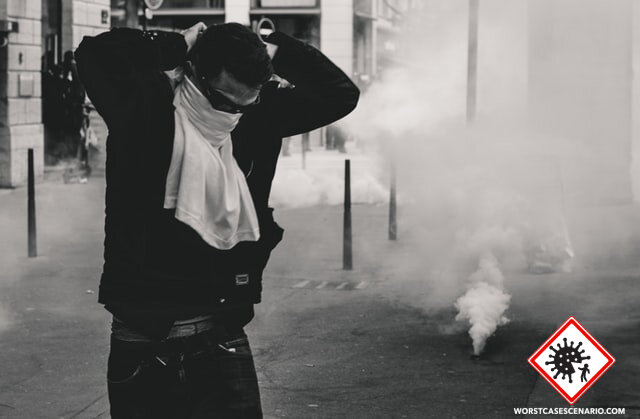How to Survive Being Teargassed
1. Quickly survey your surroundings.
When tear gas is released, it mixes into the air and fills up available space with a toxic cloud. If you suspect tear gas may be deployed, memorize as much of your surroundings as possible, including the locations of nearby exit routes like open streets. Mentally note the location of fixed obstacles including parked cars, streetlights, and crowd-control barriers. Do this to make navigation and escape easier if you are temporarily blinded by the gas.
2. Stay calm.
You may be temporarily blinded, but it is unlikely that you will suffer serious or permanent injury from the gas itself. You are more likely to become injured by dangerous collisions with panicked protestors, fixed obstacles, or authorities.
3. Protect your face and airway.
Immediately close your eyes and cover your nose and eyes with your shirt, a cloth hat, a bag, or your hands. (Wear a handkerchief or scarf in addition to a mask to be prepared.)
4. Move.
Locate the nearest exit route or open area that has not been hit. The gas will be carried by prevailing winds, so avoid running downwind. Run upwind or laterally to escape clouds of gas, moving to a higher elevation if possible. The effects of tear gas can linger in the air for hour or even days.
5. Keep your eyes closed.
Resist the temptation to open your eyes until you have clear, cool water available to rinse them. Once away from the gas, move protective clothing (or hands) away from your face to reduce continued exposure to the gas that may have collected.
6. Rinse your face and airway with clean water.
Presoaking a bandana or scarf with lemon juice or Coca-Cola is often recommended to reduce the pain of tear gas exposure. However, rinsing the eyes and airway with clean water is the best solution to clear the chemical from your face. After exposure, wash any clothing that has been in contact with the gas.
PRO TIPS
Despite its name, tear gas is not a true gas. The chemicals are solids and are typically dispersed within a thick fog. The chemicals trigger tearing, but even exposure to small amounts of tear gas can cause other discomfort: burning eyes, pain in your nose, nausea, chest tightness, shortness of breath, stomach ache, and diarrhea.
A solution of liquid Maalox mixed 50/50 with water in a spray bottle and sprayed into the eyes and mouth (and swallowed) may reduce the effects of tear gas.

